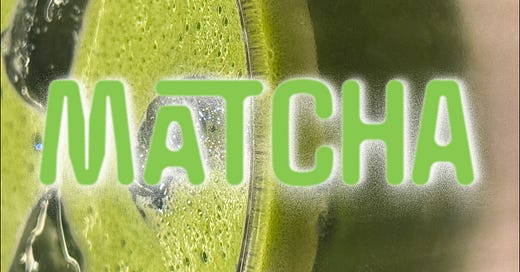If you sit in a cafe in Bandra, in the heart of Mumbai, and scan the tables and overhear conversations, you might slip into a world where people drink iced green drinks and talk about their food businesses. “My social media agency is asking me to get into matcha, it’s the new thing everyone is talking about,” a woman sitting next to me blurts out, unaware of what I am doing – sitting alone, with a pen and paper in front of me, sipping my coffee slowly.
I got into the matcha rabbit hole (even before drinking it more than twice) because of a piece I wrote three months ago for a magazine, where I elaborated on what luxury means when it comes to food. My hypothesis was that luxury in 2025 is eating seasonally and at source — feni in Goa, mangoes in summer, ker sangri in Jaipur, and coffee from Chikmagalur and so on. This is also the time when I was following Claire Dinhut’s (@condimentclaire) trip to Japan where she visited a wasabi farm and highlighted that most of us are eating fake wasabi that’s made of horseradish and mustard (made green with green food colouring or spinach juice) instead one that’s made with Wasabia japonica ( OG wasabi is extremely tough to grow and is harvested once every 2 years). This insight about wasabi got me to the new shiny green thing that’s on the menu of every cafe: matcha.
The universe of tea, especially Japanese tea, is large and seemingly unending. But this one ingredient has come to define so much of what Japan symbolises and gives to the world – the ingredient, the way it should be consumed, and the rituals associated with it. As one of my friends and a serial matcha consumer once told me, “You don’t see people using a fork to whisk the matcha,” one needs to have a chasen, the bamboo whisk, always.
Even though the origin of all teas can be traced back to China. Matcha as we know it now is a product of Japan. Dating back to the Song Dynasty China (960 - 1279), matcha somewhat went through the same growing process and was enjoyed as a foamy drink, until it (brick tea, the raw material for matcha) was supposedly banned by Zhu Yuanzhang, the Hongwu Emperor. Around the same time, in 1119, Eisai, a Zen master and Buddhist monk brought green tea seeds to Kyoto for its medicinal/health benefits. Green tea eventually became a drink enjoyed by the elite class, and in order to keep the supply consistent, farmers started covering the tea plants to protect them from frost damage…this practice of shading the trees for 3-4 weeks before harvesting resulted in the flavours of tea becoming mellower.
This almost accidental technique of shading the tea plants became a prerequisite for producing matcha. The process of shading works to artificially reduce the amount of sunlight reaching the plants. To a layman, this process might seem counterintuitive to the way we have learnt photosynthesis…plants need sunlight to grow and prosper, right? But the shaded tea-plant produces more chlorophyll to capture the limited amount of light that is available to it. This is what gives matcha its distinct, vibrant green colour. And because of less sunlight, the process of photosynthesis slows down, the breakdown of glucose is less in plants, so it begins breaking down protein into amino acids as an alternate energy source — primarily the amino acid L-theanine. The lack of catechin (a compound produced under heat and sunlight that gives tea its bitter, astringent taste) also contributes to matcha’s sweet, umami flavour.
But this is where it gets a little bit more complex – the order and way of picking the leaves and the way it’s processed dictates the flavour and quality of the product. “All true matcha is ichibancha – the first pick of the year,” and every single leaf is a different type of tea. The first 2-3 leaves of the tea plant are reserved for sencha or gyokura ( as they receive most amount of sunlight) and the next, big leaves are tencha, the raw material used to make matcha. I might be writing this casually, but I am completely gobsmacked to have discovered that a single leaf can be classified as a specific tea.
After harvesting, the leaves are steamed to stop oxidation and to “preserve their green colour, fresh aroma, and vegetal, savoury taste,” and they go through a few steps before being ground using granite stone mill. The more I learn about this green powder i.e. matcha, the more I am in awe of every detail. It's almost as if each step, however small it might seem, dictates how matcha is produced. There’s a remarkable precision in the way matcha is produced — from the specific region and leaves to the methods of shading, harvesting, and processing — each detail shaping its quality. But even in this precision, there is no official standard or grading system that assesses or regulates the terms companies/brands put to highlight the quality of matcha. So when you see a tin labelled as “ceremonial” or “culinary” grade, it is hardly reliable. “It may come as a shock, but in Japan, there is no agreed upon classification for Matcha. None. The classification level only refers to Tencha - the unground form of Matcha…The presents a whole host of challenges - but as it stands, there is no law set of rules defining Matcha. Enter a vacuum - and vacuums love to be filled. Please meet the term “Ceremonial”, says the founder of Kettle, Zach Mangan as he explains why the brand doesn’t use the same terms to classify their products. I am compelled to ask, as the consumer market in India is flooded with brands selling matcha — How do we as consumers know what we are drinking? What is truly matcha?
In Part 2 of the matcha series, we will talk a little bit more about the complexity of matcha, the rituals, design and philosophy of drinking it.












Such a delightful read! Never knew it had such an intricate process, but in hindsight hardly surprising given its Japanese origins